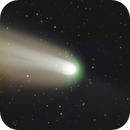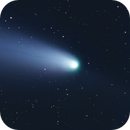Hi folks hopefully you can help me out with this one.
Processed comet A3. Abbreviated workflow - WBPP, Comet align on registered subs, StarX (large overlap) on aligned subs, image integration on starless aligned subs.
Square/block shaped artifacts appear randomly across the integrated image.
Acquisition info. ZWO2600mcp, Antlia Triband filter, Askar 140 APO, 31 x 60 sec subs. Darks, flats and dark flats.
I would appreciate any suggestions as to how to correct this issue, if not before integration, but if that is not possible how I could improve them post integration?

Comet A3
If you look at the image you can see the artifacts most pronounced in the Comet tail. Thanks in advance....
Processed comet A3. Abbreviated workflow - WBPP, Comet align on registered subs, StarX (large overlap) on aligned subs, image integration on starless aligned subs.
Square/block shaped artifacts appear randomly across the integrated image.
Acquisition info. ZWO2600mcp, Antlia Triband filter, Askar 140 APO, 31 x 60 sec subs. Darks, flats and dark flats.
I would appreciate any suggestions as to how to correct this issue, if not before integration, but if that is not possible how I could improve them post integration?

Comet A3
If you look at the image you can see the artifacts most pronounced in the Comet tail. Thanks in advance....
